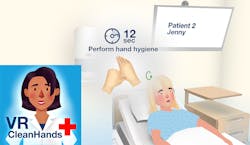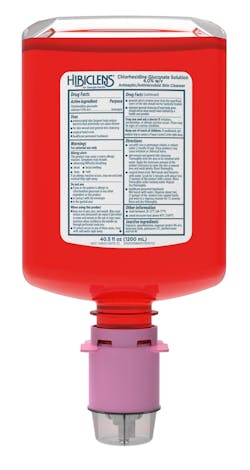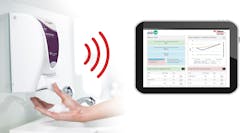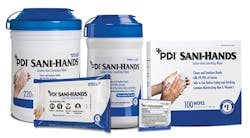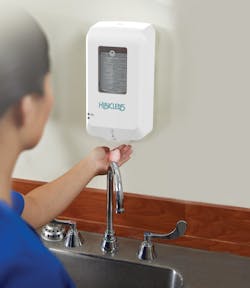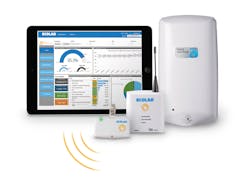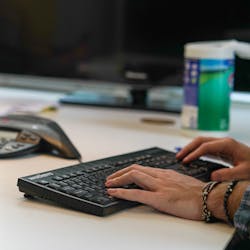When it comes to decreasing the risk of infection spread in the community and in healthcare, routine and proper hand washing and sanitizing rise to the top of best hygiene practices.
During today’s COVID-19 crisis, hand washing and disinfection is making an even bigger splash as means to help protect staff and patients from this potentially deadly disease caused by the SARS-CoV-2 virus.
Infections abound
Still, the basic, but essential act of hand washing remains a health barrier and danger for various populations, including school children in disadvantaged regions.
The World Health Organization (WHO) recently reported, “ As schools worldwide struggle with reopening, the latest data from the WHO/UNICEF Joint Monitoring Program (JMP) reveal that 43 percent of schools around the world lacked access to basic handwashing with soap and water in 2019 – a key condition for schools to be able to operate safely in the midst of the COVID-19 pandemic.”1
Like schools, healthcare providers want to help wash away germs and protect people against infections.
The Association of Professionals in Infection Control and Epidemiology (APIC) stated, “No matter where you are — a hospital, a long-term care facility, an outpatient surgery center, a dialysis center or a doctor’s office — you are at risk for infections. The most common infections associated with healthcare facilities include catheter-associated urinary tract infections; central line-associated bloodstream infections, surgical site infections, and pneumonia. Clostridium difficile infection (also known as deadly diarrhea) is another harmful illness that can develop from antibiotic use. According to the Centers for Disease Control and Prevention (CDC), 1 in 25 hospitalized patients will get an infection as a result of the care they receive. An estimated 75,000 patients will die each year.”2
Consistently cleaning hands
Hand washing and disinfection serve as a universal health and safety protocol in healthcare environments.
“Keeping up with good hand hygiene is essential to help workers and patients stay safe and healthy,” emphasized Tom Bergin, Marketing Director, Health Care, Essity Professional. “All healthcare workers should use hand sanitizers or wash their hands with soap and water at five critical moments – as prescribed by the WHO’s ‘My 5 Moments for Hand Hygiene’:
- Before touching the patient
- Before a clean/aseptic procedure
- After body fluid exposure risk
- After touching a patient
- After touching patient surroundings.”
Bergin continued, “If their hands are visibly soiled, doctors, nurses and other healthcare workers should wash their hands with soap and water. You should ensure that hand hygiene supplies are readily available to all personnel in every care location in your hospital, doctor’s office or other healthcare facilities. Engaging staff in training is also important. Tork has launched the Tork VR Clean Hand training app to help. The app is available for free and helps reinforce the proper moments of hand hygiene in a safe and interactive way.” The Tork brand is part of Essity.
Additional educational resources should be placed into the hands and minds of healthcare staff to enhance cleaning and sanitization, urges Bergin.
“By empowering EVS with the right tools, education, and effective products, they can help mitigate the risk of infection spread and keep operations running efficiently,” he said. “Tork has launched the COVID-19 tool kit for healthcare. This document summarizes tools, education materials, and recommended products that help maintain a safe and hygienic care environment.”
David Cassidy, BSN, RN, Mölnlycke, looks to the CDC’s guidance for hand washing and stresses hand washing as a number one practice to defend against contagion.
Martin McGonagle, General Manager, SC Johnson Professional, Healthcare, points to the WHO’s guidance for handwashing and the company’s hand sanitizer and hand hygiene system for staff disinfection and patient safety.
“The spotlight on proper hand hygiene has never been brighter,” McGonagle expressed. “SC Johnson Professional’s Alcare Extra Foaming Hand Sanitizer contains 80% Ethanol and moisturizing agents to leave the hands feeling smooth and refreshed after use. This ABHR product is proven to eliminate up to 99.9999% of tested organisms in 15 to 20 seconds when used correctly. With the use of our DebMed System, healthcare facilities are provided with a trusted method of monitoring hand hygiene during direct patient care. The stand-alone system uses monitoring-enabled, point-of-care and wall mount dispensers to register events and measure compliance with the WHO’s ‘My 5-Moments for Hand Hygiene’ and other best practice guidelines.”
Antibiotic cleansers, like those from Mölnlycke, help decrease the risk of pathogen spread.
“Hibiclens is an antiseptic skin cleanser used for hand hygiene as well as patient bathing,” Cassidy called out. “Hibiclens’ proprietary formulation contains four percent CHG for a broad antimicrobial effect. We are excited to be partnering with Georgia-Pacific to introduce Hibiclens in an automated dispenser solution – Hibiclens Antimicrobial Soap System by GP PRO. The automated, touchless dispenser can help reduce cross-contamination risk and can be positioned at every hand washing station to ensure easy access.”
Ongoing education and ample supplies for hand hygiene are critical for compliance, expresses Caitlin Stowe, MPH, CPH, CIC, CPHQ, VA-BC, Clinical Affairs Research Manager, PDI.
With the heightened risk of COVID-19 spread, the CDC recommends additional hand hygiene measures for the safety of healthcare personnel (HCP), patients and visitors, including, “HCP should remove their respirator or facemask, perform hand hygiene, and put on their cloth face covering when leaving the facility at the end of their shift. Educate patients, visitors, and HCP about the importance of performing hand hygiene immediately before and after any contact with their facemask or cloth face covering.”3
Hand hygiene compliance
How can healthcare providers work to achieve hand hygiene compliance and safety in care? Cassidy suggests professional education, visual monitoring and monitoring systems for support.
McGonagle turns to a solution-based approach for tracking, evaluating and sharing information about hand hygiene and compliance.
“For example, Leapfrog’s new hand hygiene standard includes five domains: monitoring, feedback, training and education, infrastructure, and culture4,” he indicated. “The standard encourages facilities to adopt this multimodal approach to hand hygiene, emphasizing the importance of monitoring and feedback. The solution, therefore, is to measure hand hygiene compliance with an evidence-based and validated electronic hand hygiene monitoring system that can track every hand hygiene event and provide the data needed to support ongoing improvements and compliance.”
The Hand Hygiene Compliance Monitoring system by Ecolab Healthcare provides added accountability and extra security in care, brings forth Linda Homan, RN, BSN, CIC, Senior Manager of Clinical Affairs, Ecolab Healthcare.
“The pandemic has reinforced the importance of fundamental infection control practices, such as hand hygiene,” Homan explained. “Ecolab’s system has enabled our customers to ensure hands are washed before and after every patient. It allows hospitals to record hand hygiene events automatically and accurately by individual and provides immediate feedback to keep staff accountable, driving a two-times average improvement in hand hygiene compliance and resulting in sustained post-implementation compliance levels of 80 to 90 percent. To quote one customer, ‘If I didn’t have this system, I wouldn’t have a clue about what is going on with hand hygiene! We are trying to restart our ‘usual’ activities, but with staffing cuts it is difficult. The beauty of the system is I can send reports to those above me to get my point across – I don’t have to depend on manual observations.’”
COVID-19, however, may disrupt the flow of monitoring compliance, or, on the other hand, may open the door to new improvements, observed Stowe.
“While direct observation is the gold standard when it comes to evaluating proper hand hygiene, this may not be possible during the pandemic5,” she stated. “Staff normally responsible for monitoring hand hygiene compliance are increasingly relying on alternative methods, such as hand hygiene product usage calculations and secret shopper observations performed by other staff members to monitor compliance. While none of these are perfect, any of these methods can be used to benchmark current performance and identify opportunities for improvement.”
Disinfecting equipment
In addition to hand hygiene, computer keyboards and other equipment touched by staff are critical to clean and disinfect in healthcare facilities.
“All work environments have varying degrees of shared spaces and opportunities for cross-contamination, and many of them are commonly overlooked,” said Matt Dombrowski, Sales Manager, WetKeys Washable Keyboards. “Now more than ever, the mindfulness for cross-contamination has made WetKeys Washable Keyboards essential personal protective equipment (PPE). We are thrilled that our products are being used to outfit hospitals and other healthcare facilities with sanitary typing equipment. Our hospitals partners are now purchasing washable keyboards and mice for administrative areas and patient intake zones because these have previously been blind spots in their infection prevention plans.”
“At WetKeys, we are adamant about good hand hygiene, and each team member has a favorite song they hum while washing their hands for the recommended twenty seconds,” he shared. “While our team is hypervigilant about hand hygiene, we also use a standard washable ABS plastic keyboard, like the KBWKABS104-BK, at our desk and in our conference room to ensure a hygienic, safe work environment. They (hospitals and healthcare facilities) have put out hand sanitizer and hand washing guide signs above sinks, but monitoring and measuring is a hurdle. It is much easier to maintain and enforce hand hygiene for the usual high-risk environments, like operating and examination rooms. Our SaniType keyboards, designed for these specific areas, have a ‘sanitize for prevention’ reminder printed on them.”
Next wave of hand hygiene
What’s in store for the future of hand hygiene practices and compliance? Homan predicts that technology will advance to allow better tracking of hand washing activity and compliance.
“New wearable technology, for example, is advancing quickly,” she noted. “In fact, Apple has recently enabled the iWatch to recognize when you are washing your hands and provided a timer to ensure they are washed for the full 20 seconds. We see this type of advancement being especially useful in acute care facilities, but it will also be helpful in making people mindful of hand hygiene across many different environments, such as schools, offices and sports arenas – and that’s really exciting.”
Stowe agrees technology must develop and climb to the forefront of hand hygiene in care.
“The next generation of hand hygiene should be fully automated and more accurate than direct observation,” she said. “This could be accomplished through the use of enhanced radio frequency identification (RFID) technology. This will be able to track compliance down to the specific person and hand hygiene dispenser and at what specific indication hand hygiene was performed. Future hand hygiene compliance technologies will allow facilities to collect robust hand hygiene observations and monitor intervention effectiveness in real time.”
Dombrowski envisions continued focus on disinfecting devices and surfaces touched in public spaces.
“The next generation of hand hygiene is community-based protection. Hand hygiene is personal and can be tricky to enforce in all areas,” he stated. “One set of dirty hands using a shared keyboard at a data entry station without cleaning contaminates all the clean hands. Washable keyboards and mice help to combat this human element and reinforce the hand hygiene of the entire hospital. It is hard to monitor and measure personal hygiene. Broadly deploying washable keyboards and mice, a commonly shared surface, becomes a keystone in making a robust infection prevention plan.”
Hygiene Product Spotlights
* ©2020 GP PRO. All rights reserved. Unless otherwise noted, all trademarks are owned by or licensed to Georgia-Pacific Consumer Products. The Mölnlycke and Hibiclens trademarks, names and logo types are registered globally to one or more of the Mölnlycke Health Care Group of Companies. © 2020 Mölnlycke Health Care AB. All rights reserved.
References:
- UNICEF, WHO report two in five schools around the world lack basic handwashing facilities. https://www.who.int/news-room/detail/13-08-2020-2-in-5-schools-around-the-world-lacked-basic-handwashing-facilities-prior-to-covid-19-pandemic-unicef-who
- What are healthcare-associated infections? https://apic.org/monthly_alerts/what-are-healthcare-associated-infections/
- Interim Infection Prevention and Control Recommendations for Healthcare Personnel During the Coronavirus Disease 2019 (COVID-19) Pandemic. https://www.cdc.gov/coronavirus/2019-ncov/hcp/infection-control-recommendations.html
- Leapfrog Hospital Survey. Factsheet: Hand Hygiene Last Revision: 4/1/2020. https://www.leapfroggroup.org/sites/default/files/Files/2020%20Hand%20Hygiene%20Fact%20Sheet.pdf
- World Health Organization. My 5 Moments for Hand Hygiene. https://www.who.int/infection-prevention/campaigns/clean-hands/5moments/en/. Published 2020.

Ebony Smith
Ebony Smith was previously Managing Editor for Healthcare Purchasing News.

